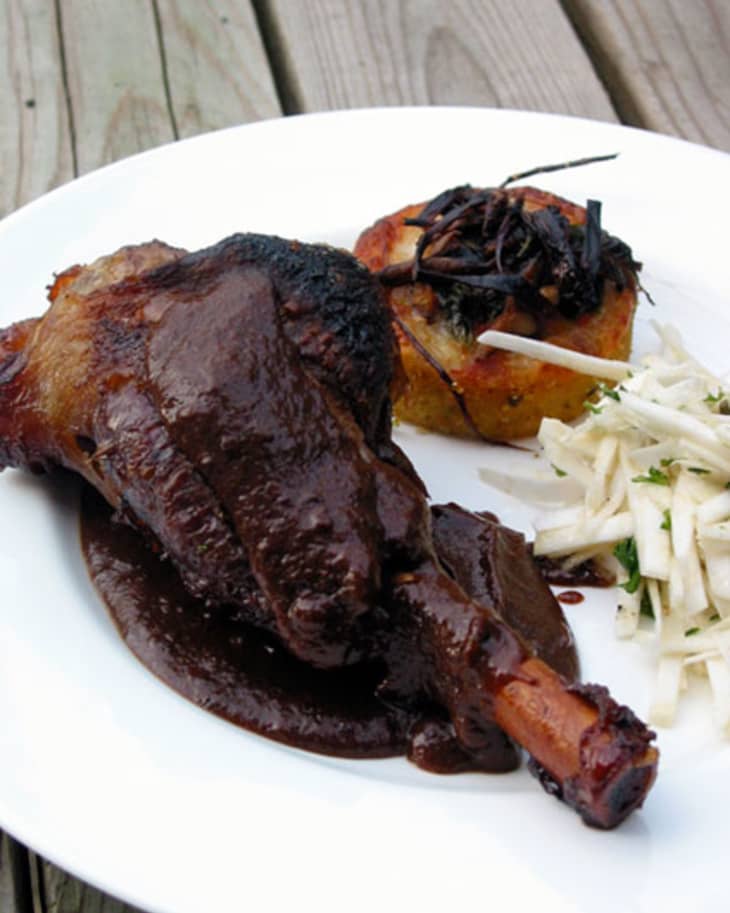Recipe: Braised Goat Shanks with Prune, Shallot, and Brandy Reduction
As we end Meat/Un-Meat month and we give you a last recipe or two for meat, I feel that it’s worth mentioning this benefit again: when we eat meat, I believe it should be in full consciousness of the animal that died so we can eat.
Goat, and to some extent lamb, is a very good meat to remember this by. It hasn’t been so squeezed into styrofoam trays and shrink wrap. When I buy my goat from my local butcher (who also raises the goats, lambs, and beef cattle they butcher) I remember that this was one unique animal, one real living thing. It wasn’t a walking piece of nameless, interchangeable protein. (Chicken breasts and ground hamburger… did they grow that way? We really could be forgiven for thinking so – when was the last time you saw a chicken with feathers or beef cow with tail?)
Of course, it’s a perfectly logical response to the sight of walking chickens, lambs, pigs, and cows to say, no, those are living animals and I don’t really want to eat them. I have quite a lot of sympathy towards vegetarianism, and it makes so much sense to me, in fact, that sometimes I wonder why I’m not a vegetarian. Am I just too calloused? Too hard-hearted? Do I lack the PETA gene? Hmmm. I’ll leave that question aside for now, and return to the central point.
My personal opinion is that those of us who eat meat on a regular basis should not be squeamish about where our meat comes from. We should be willing to take it all — bone, shank, tail, nose, ears — and do honor to the animals that we eat by using everything up from end to end. This isn’t my idea, of course; responsible butchering and use of the whole animal has been good practice around the world for thousands of years.
One of my favorite examples of this consciousness of meat comes from Barbara of Tigers and Strawberries, a truly fantastic food blog. Barbara allowed her daughter Morganna to go and help a friend butcher a cow she had helped raise by hand. She was there when they killed the cow, and she helped butcher all of it into meat that would be stored for her friend and her family. You can read the post here:
I don’t mean to preach: I am hardly the best example of this at all. It’s just a little lecture I give myself from time to time, and I do feel that it’s part of the price I ought to pay for being an omnivore. If I’m willing to eat the goat, I also shouldn’t be bothered when I have to pick out a few stray hairs from the meat. This was a living thing, and I hope that as it nourishes me I can use it responsibly.
And now, all that to say — here’s a recipe for goat! I’ll let you be the judge on whether it’s a responsible use of some very delicious and meaty goat shanks. We certainly enjoyed it. I attempted a prune and shallot sauce after having a perfectly sublime version at a favorite restaurant last winter. Mine wasn’t nearly so sublime, but it does complement the goat well. Prunes are less sweet than rich and meaty; they have a deep tannic flavor that goes well with goat and lamb.
Braised Goat Shanks with Prune, Shallot, and Brandy Reduction
2 goat shanks (3/4-1 pound each)
1 tablespoon olive oil
Salt and pepper
1/2 pound shallots, chopped
6 cloves garlic, minced
3/4 cup prunes, minced
1/3 cup brandy
1 cup chicken or beef broth
1 cup white wine
1 sprig rosemary
1 bay leaf
Preheat oven to 325. Brown the goat shanks on all sides in a heavy Dutch oven. Salt and pepper liberally and set aside.
Heat a little olive oil in the same Dutch oven. Cook the shallots and garlic until softened and fragrant. Add the minced prunes and cook, stirring, for 3-4 minutes. Add the brandy and stir to deglaze.
Place the goat on top of the shallot and prune mixture in the Dutch oven. Pour the white wine and broth over top and bring to a light simmer. Add the rosemary and bay leaf. Cover and bake in the oven for two hours.
When the meat is tender and pulling away from the bone, remove from the oven. Put the shanks on a plate and cover with foil to keep warm. Scrape out the prune and shallot mixture under the meat and puree it with a stick blender or in a food processor. Return to the Dutch oven over medium-high heat and reheat, stirring. If the sauce is very thick you may want to thin it out by whisking in another cup or two of beef broth or wine. Taste and season with salt and pepper.
Note: A note on finding goat. Goat is a great meat for eating locally; you just don’t find goat in the local grocery store, usually, so when you do find it you can be almost sure it was raised responsibly on a small farm. I usually buy goat from my butcher, but this time I was at Whole Foods and discovered that they carried goat meat raised just a few miles away.
Related: Goat Meat 101
(Images: Faith Durand)
